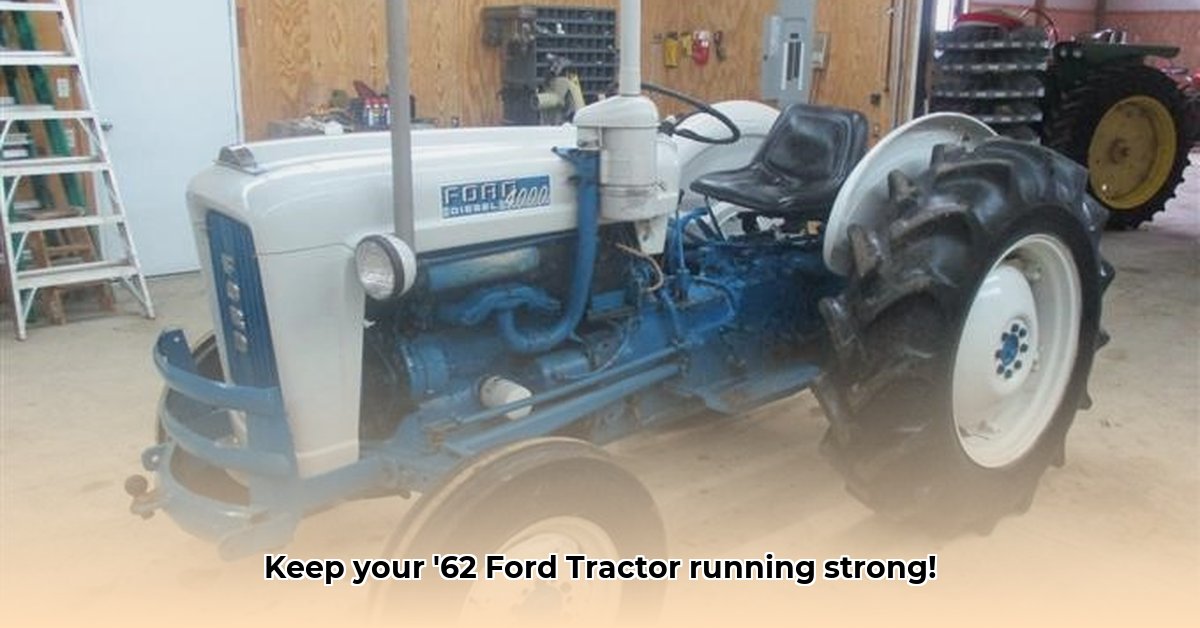
62 Ford Tractor: A Sustainable Farming Partner
The Ford 62 tractor, a symbol of agricultural resilience, presents a unique opportunity for sustainable farming. While its age presents challenges, its inherent durability and potential for repair offer a compelling alternative to constantly replacing equipment. This article explores the environmental implications of using a Ford 62 and provides actionable steps for owners, suppliers, policymakers, and researchers to maximize its sustainability. For more information on Ford 62 restoration, check out this helpful resource: Ford 62 restoration.
The Eco-Friendly Farming Challenge: Old versus New
Maintaining a classic Ford 62 involves a trade-off. Repairing it avoids the environmental cost of new tractor manufacturing. However, its fuel efficiency might be lower than modern tractors, potentially increasing emissions. This highlights a crucial aspect of sustainable agriculture: the entire lifecycle of equipment must be considered. Modern tractors, while efficient in operation, demand significant resources during manufacturing and eventual disposal. The Ford 62, conversely, offers a path towards reuse and minimal waste, so long as sustainability-focused practices are adopted.
The Parts Puzzle: Ensuring Sustainable Sourcing
Finding parts for a Ford 62 can be difficult. Original parts are scarce, and aftermarket options vary widely in quality and environmental impact. Are these aftermarket products made sustainably? Do they perform reliably? These questions are vital for maintaining the long-term sustainability of the Ford 62. The use of unsustainable materials or manufacturing processes in aftermarket parts significantly increases the overall environmental footprint.
Making Your '62 Ford Tractor a Green Machine: A Practical Guide
This section outlines actionable steps to minimize your Ford 62's environmental impact:
For Ford 62 Owners:
- Prioritize Preventative Maintenance: Regular servicing is crucial. Addressing small issues before they escalate reduces the need for major repairs, saving resources and minimizing downtime. Think of it as preventative medicine for your tractor.
- Source Parts Wisely: Research different parts suppliers, comparing cost, quality, and environmental claims. Consider remanufactured or refurbished parts as more sustainable alternatives to new ones. Meticulous record-keeping aids future maintenance and repair.
- Strategic, Compatible Upgrades: Explore upgrades focusing on fuel efficiency. However, ensure compatibility; poor upgrades can damage other tractor parts.
For Parts Suppliers:
- Promote Transparency: Clearly communicate the materials and manufacturing processes used to enhance consumer trust and highlight sustainability efforts. This boosts customer loyalty and demonstrates a commitment to responsible practices.
- Champion Remanufacturing: Invest in remanufacturing and refurbishing programs. This drastically reduces resource consumption and extends the lifespan of older tractors.
For Policy Makers:
- Incentivize Repair: Implement policies to encourage repair and refurbishment over replacement. Tax incentives or subsidies could make maintaining older machinery more economically viable.
- Employ Holistic Life Cycle Assessments: Environmental regulations should consider the entire lifecycle of farm equipment – from manufacturing to disposal – to accurately determine the overall environmental impact.
For Researchers:
- Conduct Life Cycle Assessments (LCAs): Comparative LCAs between the Ford 62 and modern tractors are crucial. These analyses would illuminate the environmental trade-offs involved in choosing older versus newer equipment.
- Innovate for Legacy Equipment: Research into improving the efficiency and lifespan of older machinery is essential. This may involve leveraging new technologies or optimizing existing components.
The Broader Picture: Sustainable Agriculture's Future
The Ford 62 represents a wider discussion about sustainable agriculture. While maintaining older equipment offers significant environmental advantages, informed decision-making requires a holistic approach. Balancing economics and environmental stewardship is crucial for building a sustainable agricultural future. The Ford 62, therefore, offers vital lessons in resourcefulness and sustainability that can be applied more broadly.
Reducing the Environmental Impact of Older Farm Equipment
Your Ford 62 can contribute to a sustainable future. Here are further ways to reduce its environmental impact:
Optimizing Your Tractor's Operation
Regular maintenance is key to maximizing fuel efficiency, thus reducing emissions. Neglecting maintenance leads to higher fuel consumption and increased pollution.
Maintenance Optimization Steps:
- Regular Oil Changes: Reduces wear and tear.
- Filter Replacements: Ensures proper combustion.
- Tire Pressure Monitoring: Improves fuel efficiency.
- Belt Adjustments: Maintains peak performance.
- Engine Tuning: Minimizes fuel consumption and emissions.
Exploring Alternative Fuels
Biodiesel, a renewable fuel, offers a greener alternative to conventional diesel. Though availability and cost may differ, it represents a substantial step towards lowering the tractor's environmental impact.
Biodiesel Considerations:
| Pros | Cons |
|---|---|
| Reduced greenhouse gas emissions | Potentially higher cost |
| Renewable resource | Availability may vary |
| Biodegradable | May require engine modifications (in some older models) |
Precision Agriculture Techniques
Precision agriculture can reduce resource waste, even with older tractors, by optimizing fertilizer and pesticide applications.
Implementing Precision Techniques:
- GPS Guidance: Reduces fuel consumption and overlaps.
- Variable Rate Application: Applies inputs precisely based on soil conditions.
- Yield Monitoring: Improves future planning and resource allocation.
Extending Tractor Lifespan
Repairing instead of replacing your Ford 62 reduces waste and material consumption significantly. This emphasizes the inherent sustainability of durable, repairable equipment.